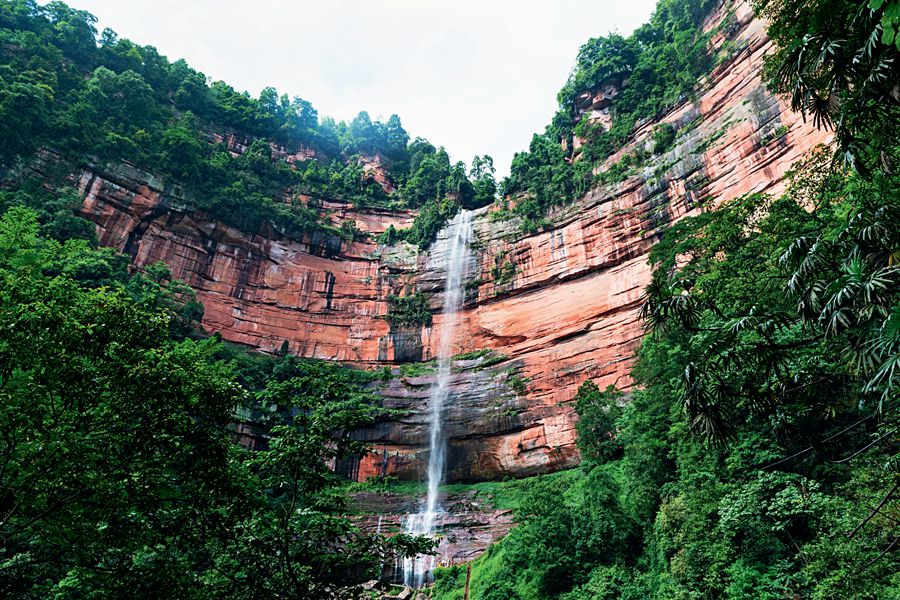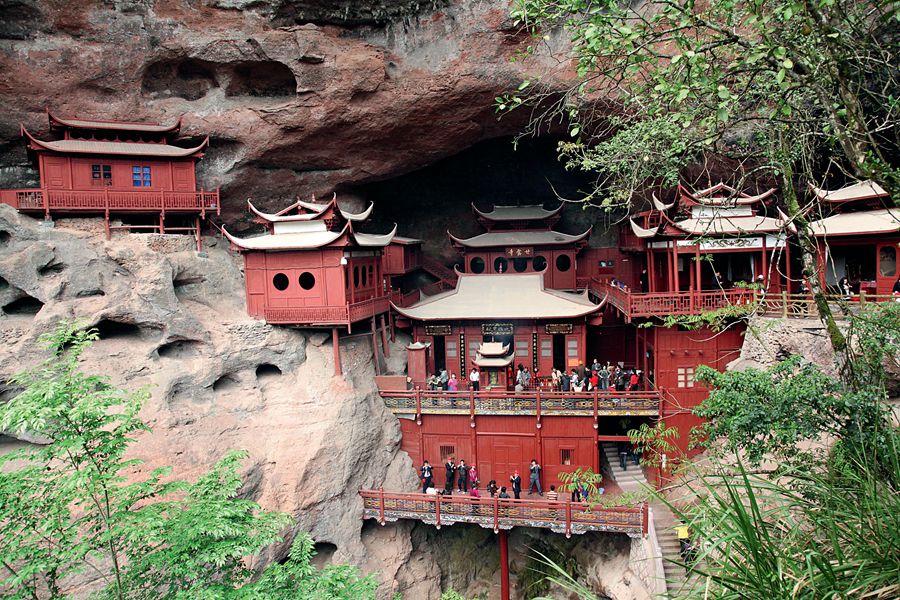A Danxia landform is a red-bed landform characterized by steep cliffs. It was initially discovered and named by Chinese scholars. Although there are red-bed landforms in many parts of the world, China, with a special fondness for the color red, boasts the most widely distributed Danxia possessing unique characteristics. This is a mesmerizing natural formation and a special gift that nature has bestowed upon this country.
China has so far discovered more than 800 locations of Danxia landform, among them, six in the provinces Guangdong, Zhejiang, Jiangxi, Fujian, Hunan, and Guizhou are the most representative ones. These six regions fully demonstrate the complete evolution of Danxia from early stages to old age. Their uniqueness and integrity have won international recognition. In 2010, the six regions were successfully listed on the World Heritage List under the name “China Danxia.”
Foguangyan in Chishui, Guizhou Province, is known as the crown of Danxia landform throughout the world.
Danxia Mountain in Guangdong
The Danxiashan Geopark is located in Shaoguan City, Guangdong Province. It consists of more than 680 red gravel rocks with flat tops, steep bodies, and a gentle piedmont. The word Danxia comes from an ancient Chinese poem, describing rosy clouds in the sky. The red cliffs there resemble rosy clouds, so it is called Danxia Mountain. In 1928, the Chinese scholar Feng Jinglan came here to see the strange stones, stone bridges, and stone caves formed by the red gravel due to running water and wind erosion. Realizing that this was a unique landscape, he named them Danxia. Later, more similar landforms were discovered, and the Danxia landform officially became an academic term.
As the largest scenic spot in Guangdong Province, Danxia Mountain consists of three connected peaks, namely Zhanglao Peak, Hailuo Peak, and Baozhu Peak. Among the three peaks, the Hailuo Peak is the most magnificent. According to geological research, more than 20 million years ago, the area was a huge lake. Later, due to the rise of the earth’s crust, the lakebed was outcropped, and the rock stratum was eroded away by wind and rain and turned into the natural wonder that it is today. The Danxia Mountain has become a base for research, scientific education, and teaching of Danxia landform in China and the world.
There is plentiful breathtaking scenery, such as stone peaks, stone walls, stone pillars, and natural bridges in the area. The main scenic spots are Yangyuan Stone, Zhanglao Peak, Xianglong Lake, and Jinjiang Gallery. The Danxia Mountain has a variety of scenery for visitors to see in each season. In the morning, one can see the wonders of the sunrise and the sea of clouds; in the evening, one can observe a beautiful sunset and the quiet night. Standing on the peak, a panoramic view of layer upon layer of peaks and knolls is visible. The surreal landscape paints a vivid scene at all times.
As early as the 12th century, many Taoists came here to build temples. The literati of the past dynasties also left many poetic inscriptions. Therefore, there are many historical sites in the Danxia Mountain, which hold great historical and cultural value.
Chishui Danxia
Chishui in the northwestern part of Guizhou Province is a city named after a river, the Chishui River, which is a tributary of the upper reaches of the Yangtze River. The city is also known throughout the country because the Red Army crossed the river four times during the Long March and defeated enemy troops with a force that was smaller in number.
Sweet Dew Temple in Taining Geopark boasts a history of over 860 years.
The Chishui Danxia National Geopark in the middle and lower reaches of the Chishui River is representative of the Danxia landform in the early stage. Totaling more than 1,200 square kilometers, Chishui Danxia is located in the subtropical zone, with a humid climate and abundant precipitation. With a forest coverage rate of more than 95 percent, it is home to many rare plants, such as the spinulose tree fern. Numerous rivers flow down from the top of the mountain, developing a typical canyon terrain, with a large number of horseshoe-shaped cliffs and waterfalls. Due to superior natural conditions and limited human activity, the sites are well preserved. This geopark includes the Suoluo National Nature Reserve, Zhuhai National Forest Park, and Yanziyan National Forest Park, as well as thousands of scenic spots. Canyons, cliffs, streams, and waterfalls are found all over the area. The landscape is characterized by high terrain, deep valleys, cliffs, and waterfalls.
Foguangyan is a famous scenic spot in the core area of Chishui Danxia, with the Dabai Rock and the Wuzhu Peak as the main attractions. The Dabai Rock is a ring-shaped Danxia cliff with a height of 234 meters, a width of 666 meters, and an arc length of more than 1,000 meters. It looks like a huge book spread out in the middle of the clouds. Under the bright rays of the sun, the cliff appears gorgeous. A waterfall cascades from the middle of the stone wall, and the floating mist resembles smoke, giving the red cliff a stunning appearance. The Wuzhu Peak is composed of five tower-like Danxia peaks. The overlapping stone pillars are covered with dense grass ferns and vines, which contrast sharply and beautifully with the exposed red stone cliff.
Chishui is known as the city of 1,000 waterfalls. Waterfalls cascading off cliffs can be seen everywhere around the park. The most famous one is the Chishui Waterfall, which is 76 meters high and 80 meters wide. It is the largest waterfall on the Danxia landforms in the world and the largest waterfall in the Yangtze River Basin. The waterfall gushes down from the cliff and appears like thousands of horses stampeding with great momentum. The mist under the sun presents colorful rainbows.
Taining Geopark
Located in Sanming City, northwest Fujian Province, Taining Geopark is a large comprehensive geological park primarily made up of Danxia landforms as well as granite and volcanic landforms.
The park boasts meandering ravines and gullies. The canyons are deep, the cliffs are towering, and there are numerous caves. The extensive water system in the region and the complex fracture system formed by multi-phase tectonic activities created a unique landform. The strange mountain peaks, the mysterious Danxia caves, and the deep and quiet canyons make up the magical scenery.
The park consists of four areas, namely Shiwang, the Dajin Lake, the Baxian Cliff, and the Jinnao Mountain, in addition to Taining Ancient City. The Zhaixia Grand Canyon Scenic Area in Dajin Lake area is a Danxia landform in early stages. It is composed of three canyons connected end to end that form a circular triangle, like a golden dragon lying in the mountains. Therefore, it is also known as Jinlong (Golden Dragon) Valley.
The Zhaixia Grand Canyon is an excellent place to see the typical red cliffs, caves, valleys, and barrier lakes of Danxia Landforms. The cliffs on both sides of the canyon are steep, and it is rare to see the sun. Walking into the deep and serene canyon, the feeling of being separated from the world is soothing. The Tianqiong Rock is the most attractive part. At the top of the red cliff, there is a concave rock about 20 meters in diameter with hundreds of Danxia caves of different sizes and shapes. Seen from the bottom of the valley, it looks like a sacred yurt in the sky.
The history of Taining has been closely related to the magical and beautiful Danxia landforms. Many Danxia caves have become the holy places of Buddhist monks and nuns. Some have become serene lands for scholars to study with complete focus, some have become the homes of farmers, and some have become destinations where people can find peace for the soul. It gave birth to the humanistic history of Taining, highlighting the unique Danxia cave culture in the region.

